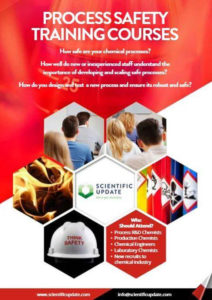When I first started working as an industrial process chemist one of my more experienced colleagues told me that you can only really know how well a process performs until you run it on at least a 5 kg scale. I found that to be good advice but as I developed my skills in the kilo lab that I was able to develop work-arounds for steps in a process that were far from perfect. Got a slow filtration? Grab five large Büchner funnels and do the filtration in parallel! However, when I first went to the pilot plant, I learned the hard way that there was only one filter available and that we were just going to have to wait for the next 18 hours for the slow filtration to complete, putting us a day behind schedule. Ever since then I’ve had an interest in reading journal articles describing development and implementation of processes on hundreds of kilo scale because every detail must be examined and refined to give a process that works flawlessly. I therefore enjoyed reading a recent publication that describes the development of multiple high-volume manufacturing routes to a carboxylic acid intermediate to Dalcetrapib – a potential atherosclerosis treatment that Roche developed from 2004 to 2012 (Harnett, G. J. et. al. Org. Process Res. Dev. 2023, 27, 2329–2344.)

One the most important insights that I have gained over my career from reading papers on the development of chemistry for materials required on multi-ton scale is what types of chemistry can be implemented readily on that scale, and which ones are better avoided. For example, the initial route used LDA as a base to introduce an alkyl side chain onto a cyclohexyl ring, and although this was implemented on 100’s of kg scale, they decided to swap to using a Grignard reagent because they knew from previous in-house experience making Naproxen that methyl magnesium chloride can be made by a simpler procedure than either n-BuLi or LDA. Magnesium is also naturally more abundant than lithium, so this is more economical and sustainable. Such knowledge of all raw material inputs is vital when developing a process that might be used for decades on multi-ton scale.
Based on my experiences in graduate school scaling-up a Birch reduction to a few tens of grams I would not have thought that this would be an option for pilot plant manufacture. However, much to my surprise about 10 years later an operator at a CDMO showed me the plant reactor set-up that they had for a dissolving metal reduction for another customer’s project. I’m still not sure whether I was glad or disappointed that I never got to see them adding brick-sized lumps of sodium into the vessel via what they described as ‘the torpedo tube’. So, it was fascinating to see in this paper that the authors developed a route where the first step of the process was a Birch reduction of benzoic acid using Li. Interestingly the authors showed that methyl amine could be used in place of ammonia, something that I’d read was possible but never seen an example of before. This solvent switch enables the reaction to be performed at -6 to -12 C rather than cryogenic temperatures thereby saving a lot of energy to cool the reactor and significantly reduce the risk of catastrophic off-gassing in the event of a cooling failure.
Finally, the paper also includes one reaction performed in the plant in batch that I would not have imagined possible. In one of the developed routes the final step was to hydrolyze an unreactive nitrile to carboxylic acid. The experimental procedure reported in the main paper involves heating the nitrile in the presence of methanol and aqueous sodium hydroxide for 16 h at 203 C in a 1400 L Hastelloy vessel rated for 40 bar pressure!
Scale-up of processes to these types of scale requires excellent coordination between chemists, chemical engineers and experts in process safety. Scientific Update offers three different on-line training courses on how to safely scale-up processes for the plant as follows:
Chemical and Process Safety for Development Chemists concentrates on heat and gas evolution and how to deal with and plan for these issues as you scale up along with the importance of stability data for individual chemicals and reaction mixtures.
Safety & Selectivity in the Scale Up of Chemical Reactions is aimed very much at choosing the right chemical reaction, catalysts/reagents/solvents/reaction conditions, to carry out a particular transformation, so essentially an organic chemist’s approach to process safety.
The Design & Development of Safe Chemical Processes looks in detail at the various safety tests (and equipment) that you can use in the lab at the various stages of development to build up your basis of safety as you scale up the chemistry and what emergency relief systems are available. This course is run in conjunction with Dekra Process Safety.









